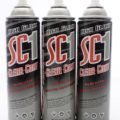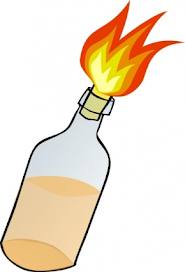 Someone recently commented about how obsessed Dual Sport riders are with fuel. It’s true, not since 1982’s post-apocalyptic classic The Road Warrior has a group of people been so preoccupied with gasoline. That’s probably because no other branch of recreational motorcyclist is so dependent on it. Road bikes can simply take the next exit, trail bikes can head back to the staging area, and motocross bikes can pull in to the pits. But running out of gas on a Dual Sport in the middle of nowhere can make you the star of a Search and Rescue story on the local evening news. So we spend hundreds of dollars on aftermarket tanks, or plan rides and trips based on fuel availability.
The simplest way to avoid fuel issues is to purchase an oversized gas tank for your bike. These aftermarket tanks come in different sizes: 3, 4, 5 gallon capacity and several variations in between. Depending on the bike’s make and model, there’s even a 7 gallon for the true misanthropic adventurer that can never be too far away from civilization.
There’s only two reasons I have yet to buy an oversized tank for my bike: I’m cheap and I’m lazy. I don’t really want to spend hundreds of dollars on a new tank when mine is perfectly functional. Plus, for shorter rides on more technical terrain I don’t want the added girth or weight. I could purchase an oversized tank and simply swap tanks depending on where I’m riding, but (as previously mentioned) I’m lazy. I’m also busy and don’t have much spare time to fiddle with my bike. So the only other choice for me is to carry fuel in a separate container.
I have seen fuel bladders (a fuel storage ‘bag’) and other collapsible containers. I’ve also seen bikes with plastic gas cans strapped to the rear fender with bungee cords and duct tape. But these would be awkward for me to mount and eventually I’d spend as much money on duct tape as I would on an oversized tank. Besides, I hit the ground occasionally and I’d be afraid they’d crack, tear, or burst. For me, the only viable option is a fuel bottle.
Fuel bottles aren’t exactly a complex accessory. For the most part they’re a light weight extruded aluminum bottle with a cap. But as it turns out there are some subtle differences, mainly in the cap. Shopping around online and reading many customer reviews, there are quite a few conflicting opinions about which fuel bottles are the best. All these reviews are based on not what the bottle can do, but what it shouldn’t do – which would be leak.
Someone recently commented about how obsessed Dual Sport riders are with fuel. It’s true, not since 1982’s post-apocalyptic classic The Road Warrior has a group of people been so preoccupied with gasoline. That’s probably because no other branch of recreational motorcyclist is so dependent on it. Road bikes can simply take the next exit, trail bikes can head back to the staging area, and motocross bikes can pull in to the pits. But running out of gas on a Dual Sport in the middle of nowhere can make you the star of a Search and Rescue story on the local evening news. So we spend hundreds of dollars on aftermarket tanks, or plan rides and trips based on fuel availability.
The simplest way to avoid fuel issues is to purchase an oversized gas tank for your bike. These aftermarket tanks come in different sizes: 3, 4, 5 gallon capacity and several variations in between. Depending on the bike’s make and model, there’s even a 7 gallon for the true misanthropic adventurer that can never be too far away from civilization.
There’s only two reasons I have yet to buy an oversized tank for my bike: I’m cheap and I’m lazy. I don’t really want to spend hundreds of dollars on a new tank when mine is perfectly functional. Plus, for shorter rides on more technical terrain I don’t want the added girth or weight. I could purchase an oversized tank and simply swap tanks depending on where I’m riding, but (as previously mentioned) I’m lazy. I’m also busy and don’t have much spare time to fiddle with my bike. So the only other choice for me is to carry fuel in a separate container.
I have seen fuel bladders (a fuel storage ‘bag’) and other collapsible containers. I’ve also seen bikes with plastic gas cans strapped to the rear fender with bungee cords and duct tape. But these would be awkward for me to mount and eventually I’d spend as much money on duct tape as I would on an oversized tank. Besides, I hit the ground occasionally and I’d be afraid they’d crack, tear, or burst. For me, the only viable option is a fuel bottle.
Fuel bottles aren’t exactly a complex accessory. For the most part they’re a light weight extruded aluminum bottle with a cap. But as it turns out there are some subtle differences, mainly in the cap. Shopping around online and reading many customer reviews, there are quite a few conflicting opinions about which fuel bottles are the best. All these reviews are based on not what the bottle can do, but what it shouldn’t do – which would be leak.
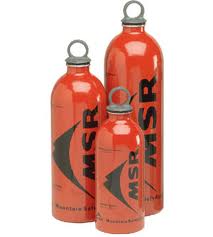 MSR and Optimus offer nearly identical products with an identical problem, the childproof cap. There were numerous complaints about the cap weeping fuel, full-on leaking, or being difficult to open. The solution to this seems to be either buying a different cap or carefully dismantling the childproof version, removing the spring, and JB Welding the cap back together. I would add one more complaint about these bottles – the mouth is only an inch wide. Filling a bottle at the pump or from a larger container can be a little messy; gas doesn’t pour as nicely as some other liquids, like bourbon. A larger opening can make it less tricky and easier to see the fuel level inside.
MSR and Optimus offer nearly identical products with an identical problem, the childproof cap. There were numerous complaints about the cap weeping fuel, full-on leaking, or being difficult to open. The solution to this seems to be either buying a different cap or carefully dismantling the childproof version, removing the spring, and JB Welding the cap back together. I would add one more complaint about these bottles – the mouth is only an inch wide. Filling a bottle at the pump or from a larger container can be a little messy; gas doesn’t pour as nicely as some other liquids, like bourbon. A larger opening can make it less tricky and easier to see the fuel level inside.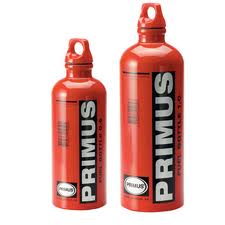 Primus is another popular brand that’s had similar issues. Searching around the internet I found this report by the Forest Service regarding use of these bottles by Fire Fighters. It seems that on several occasions as the bottle got hot the tops would pop off completely. But it should be noted that this is from almost ten years ago, so there’s a good chance that Primus got the problem sorted out.
Primus is another popular brand that’s had similar issues. Searching around the internet I found this report by the Forest Service regarding use of these bottles by Fire Fighters. It seems that on several occasions as the bottle got hot the tops would pop off completely. But it should be noted that this is from almost ten years ago, so there’s a good chance that Primus got the problem sorted out.
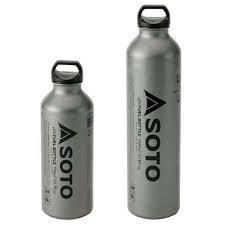 The only brand of fuel bottle I couldn’t find any negative reviews on was Soto. This could be because I couldn’t find any reviews at all. Made in Japan, these are also extruded aluminum but have a wider mouth (1 3/8 inch). I ended up buying two of their 24 oz bottles at REI, and if I fudge over the fill line a bit I can get close to an extra half gallon of gas. While this may not seem like much, it should give me an extra 20 to 30 miles depending on how hard I’m pushing and where I’m riding. So far I’ve carried these for a couple of longer rides that included some hard miles on very rough road. Rough enough to rattle my tail light, fork guards, and teeth loose. The Soto bottles had no issues with fuel weeping, leaking, exploding, or the caps popping off.
While I tend to gravitate towards purpose built products, there are cheap alternatives. Frank Morton, a retired State Trooper, avid rider, and life size action figure, carries extra fuel in several 20 oz stainless steel water bottles. Picked up from the local Gross Out (Grocery Outlet) for a few dollars each, these have an even wider 2 inch mouth which makes transferring fuel that much easier. Like all fuel bottles they can only be filled to 2/3 capacity. This is to compensate fuel expanding and pressurizing the bottle when it gets warm; preventing cap failure or getting douched with gasoline when opening the bottle. Just think of it as a container that will never be full – like a brand new bag of potato chips or box of cereal .
He cautioned me that leaving gas sit in these bottles for too many days will cause the o-ring around the cap to become impregnated with fumes. While this won’t result in little metal baby bottles, it will distort the o-ring and cause it to leak. These o-rings aren’t meant for use with petroleum products. But leaving the cap out in the sun for a few days returns it’s shape and seems to retain its seal. An easy fix for this may be to pick up a new o-ring at an auto parts store. An easier fix would be to make sure you don’t leave fuel in the bottles for too many days.
The only brand of fuel bottle I couldn’t find any negative reviews on was Soto. This could be because I couldn’t find any reviews at all. Made in Japan, these are also extruded aluminum but have a wider mouth (1 3/8 inch). I ended up buying two of their 24 oz bottles at REI, and if I fudge over the fill line a bit I can get close to an extra half gallon of gas. While this may not seem like much, it should give me an extra 20 to 30 miles depending on how hard I’m pushing and where I’m riding. So far I’ve carried these for a couple of longer rides that included some hard miles on very rough road. Rough enough to rattle my tail light, fork guards, and teeth loose. The Soto bottles had no issues with fuel weeping, leaking, exploding, or the caps popping off.
While I tend to gravitate towards purpose built products, there are cheap alternatives. Frank Morton, a retired State Trooper, avid rider, and life size action figure, carries extra fuel in several 20 oz stainless steel water bottles. Picked up from the local Gross Out (Grocery Outlet) for a few dollars each, these have an even wider 2 inch mouth which makes transferring fuel that much easier. Like all fuel bottles they can only be filled to 2/3 capacity. This is to compensate fuel expanding and pressurizing the bottle when it gets warm; preventing cap failure or getting douched with gasoline when opening the bottle. Just think of it as a container that will never be full – like a brand new bag of potato chips or box of cereal .
He cautioned me that leaving gas sit in these bottles for too many days will cause the o-ring around the cap to become impregnated with fumes. While this won’t result in little metal baby bottles, it will distort the o-ring and cause it to leak. These o-rings aren’t meant for use with petroleum products. But leaving the cap out in the sun for a few days returns it’s shape and seems to retain its seal. An easy fix for this may be to pick up a new o-ring at an auto parts store. An easier fix would be to make sure you don’t leave fuel in the bottles for too many days.
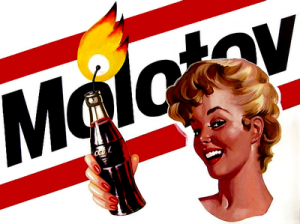 Of course there’s another not-intended-for-fuel bottle that can hold gasoline. They are earth friendly and can be quickly assembled from recycled materials. Simply take a glass bottle, fill it halfway with gasoline, and cap it with an oil-soaked rag. These are widely used in third world countries, albeit mainly by political activists instead of recreational motorcyclists. On second thought, this might not be a good idea – unless you’re going to be riding the Gaza Strip.
Regardless of how you decide to carry it, extra fuel on long rides is a good thing. It can be the difference between heading home and hiking out!
Of course there’s another not-intended-for-fuel bottle that can hold gasoline. They are earth friendly and can be quickly assembled from recycled materials. Simply take a glass bottle, fill it halfway with gasoline, and cap it with an oil-soaked rag. These are widely used in third world countries, albeit mainly by political activists instead of recreational motorcyclists. On second thought, this might not be a good idea – unless you’re going to be riding the Gaza Strip.
Regardless of how you decide to carry it, extra fuel on long rides is a good thing. It can be the difference between heading home and hiking out!



